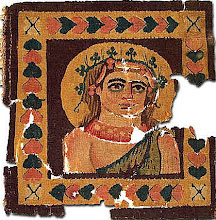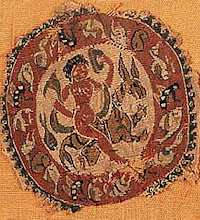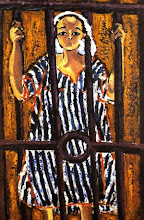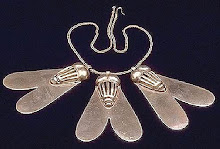Queen Hatshepsut
Hatshepsut's name means Foremost of Noble Ladies. She was the fifth pharaoh of Dynasty 18 of Ancient Egypt. Most Egyptologists regard her as one of the most successful female pharaohs, reigning longer than any other woman of an indigenous Egyptian dynasty.
Records of her reign are documented in diverse ancient sourcesIt is known that Hatshepsut assumed the position of pharaoh, and her reign as king is usually given as twenty-two years since Manetho assigns her a reign of 21 years and 9 months. The date of her death occurred in 1458, which implies she became pharaoh circa 1479 BC.
It was uncommon for Egypt to be ruled by a woman, but it was not unprecedented. Hatshepsut was the second women to have formally assumed power as "King of Upper and Lower Egypt" after Queen Sobekneferu of the Twelfth Dynasty. As a queen regnant she is preceded by Merneith of the First Dynasty; and Nimaethap of the Third Dynasty, who may have been the dowager of Khasekhemwy, but who acted as regent for her son, Djoser, during the Third Dynasty, and—she may have reigned as pharaoh in her own right.
Other women whose possible reigns as pharaohs include Nefertiti, Meritaten, Neferneferuaten, and Twosret. Another pharaoh, Smenkhkare is believed to have been male, but there is some evidence that he was actually a she.
Among the foreign rulers of the later Egyptian dynasties, the most notable example of a woman who became pharaoh was Cleopatra VII, the last to rule Ancient Egypt.
Identification of Hatshepsut's mummy
Hatshepsut's remains were long considered lost, but in June 2007 a mummy from Tomb KV60, known as the "Strong One" was publicly identified as her remains by Zahi Hawass, the chief of Egypt's Supreme Council of Antiquities. Evidence supporting this identification includes the results of a DNA comparison with the mummy of Ahmose Nefertari, Hatshepsut's grandmother. Further conclusive evidence includes the possession of a broken tooth previously found inside a small wooden box inscribed with Hatshepsut's name and cartouche: Zahi Hawass's team's CAT scan revealed that this tooth exactly matches this mummy's jaw. Modern CT scans of the mummy believed to be Hatshepsut suggest she was between 45-60 years old when she died from a ruptured abcess after removal of a tooth. There are signs in her mummy of metastatic bone cancer, as well as possible liver cancer and diabetes.
Family and early life
Hatshepsut was the elder daughter of Thutmose I and Queen Ahmose of Dynasty 18. They are known to have had only one other child, a daughter, Akhbetneferu (Neferubity), who died in infancy. Thutmose I also married Mutnofret, possibly a daughter of Ahmose I, and produced several half-brothers to Hatshepsut: Wadjmose, Amenose, Thutmose II, and possibly Ramose, through that secondary union. Wadjmose and Amenose were prepared to succeed their father, but neither lived beyond adolescence.
In her childhood, Hatshepsut is believed to have been favored by the Temple of Karnak over her two half-brothers by her father. Among the official records of her reign are assertions that her father, Thutmose I, named her as his direct heir and later, official depictions of Hatshepsut show her dressed in the full regalia of a pharaoh, including the traditional false beard to indicate that she ruled Egypt in her own right.
Upon the death of her father in 1493 BC, Hatshepsut married her half-brother, Thutmose II, commonly believed that Queen Hatshepsut exerted a strong influence over her husband.
Hatshepsut had one daughter with Thutmose II: Neferure. Hatshepsut may have groomed Neferure as the heir apparent, commissioning official portraits of her daughter wearing the false beard of royalty and the sidelock of youth.
When Thutmose II died, he left behind only one son, young Thutmose III. He was born as the son of a lesser wife of Thutmose II rather than of the Great Royal Wife, Hatshepsut, as Neferure was. Due to the relative youth of Thutmose III, he was not eligible to assume the expected tasks of a pharaoh. Instead, Hatshepsut became the regent of Egypt at this time, assumed the responsibilities of state, and was recognized by the priests of the temple. daughter, Neferure took over the roles Hatshepsut had played as queen in official and religious ceremonies.
While Thutmose III was designated as a co-regent of Egypt, the royal court recognized Hatshepsut as the pharaoh on the throne until she died. It is believed that Neferure was the royal wife of Thutmose III and mother of his eldest son, Amenemhat, who did not survive.
Thutmose III ruled for more than thirty years after the death of Hatshepsut though the official rule is said to be 55 years.
Rule -- Dates and length of reign
Hatshepsut reigned as pharaoh for twenty-two years according to ancient authors. Dating the beginning of her reign is more difficult. Her father's reign began in either 1506 or 1526 BC. The reigns of Thutmose I and Thutmose II cannot be determined with absolute certainty. Modern chronologists tend to agree that Hatshepsut reigned as pharaoh from 1479 to 1458 BC, but there is no definitive proof.
Policies
Upon the death of Thutmose II, the throne passed to Thutmose III, and Hatshepsut—as the child's royal aunt and stepmother—was selected to be interregnum regent until he came of age. Although ancient histories mark her reign from the death of her father, some scholars argue that initially, it appears that Hatshepsut was patterning herself after the powerful women who were regents during Egypt's then-recent history, but as Thutmose III approached maturity, if that was so, she could have had only one model in mind: Sobekneferu, the last monarch of the Twelfth Dynasty, who ruled in her own right. Hatshepsut took one step further than Sobekneferu, however, by being crowned pharaoh around 1473 BC, taking the throne name Maatkare, meaning "Truth in the soul of the sun god Re."
The date of her formal assumption as king is not known but this event must have occurred by her Seventh Year due to the discovery of the intact tomb of Senenmut's parents—Ramose and Hatnofer—which contained various grave goods including several pottery jars, one of which was dated to 'Year Seven' and bore the seal the 'God's Wife Hatchepsut' and two of which were stamped with the royal seal of 'The Good Goddess Maatkare', the name she took as pharaoh.
Hatshepsut surrounded herself with strong and loyal advisors, many of whom are still known today: the Vizier Hapuseneb, the second prophet of Amun Puyemre and her closest advisor, the royal steward, tutor and "overseer of all Royal Works" (or architect) Senenmut. Senenmut had two tombs constructed near Hatshepsut's tomb. This was a standard privilege for close advisors. Some Egyptologists theorize that the two were lovers. Other evidence offered is a graffito from an unfinished Deir el-Bahri tomb used as a rest house by the workers of her mortuary temple: it depicts a male and a second person of ambiguous gender with pharaonic regalia engaging in an explicit sexual act from behind. The latter person in the graffito "is wearing what has been identified as a royal headdress. Other scholars argue that the drawing has been misinterpreted "as a contemporary political parody to highlight one way in which Hatchepsut could never be a true king--she could never dominate a man in the way that she is now being dominated."
Senenmut's rapid rise in fortune at court and privileges extended to him included the placing of his non-royal tomb within the confines of Hatshepsut's temple at Deir el-Bahri. Senenmut served her father and husband also, and it may simply be that she was rewarding her servant for his great loyalty to her and his obvious skills.
Major accomplishments
Hatshepsut reestablished trade networks disrupted during the Hyksos occupation of Egypt in the Second Intermediate Period. The wealth of Dynasty 18 was unprecedented with evidence from the discovery of the burial of one of her descendants, Tutankhamun.
She oversaw preparations and funding for a mission to the Land of Punt. The expedition set out in her name with five ships, each measuring 70 feet long with several sails and accommodating 210. Many trade goods were bought in Punt, notably myrrh, said to have been Hatshepsut's favorite fragrance. The Egyptians returned from the voyage bearing 31 live frankincense trees. This was the first recorded attempt to transplant foreign trees. Hatshepsut had these trees planted in the courts of her mortuary temple complex. She had the expedition commemorated in relief at Deir el-Bahri, also famous for its depiction of the Queen of the Land of Punt, who is depicted as quite obese with rolls of fat and steatopygia.
Although many Egyptologists claimed that her foreign policy was peaceful, there is evidence that Hatshepsut led successful military campaigns in Nubia, the Levant, and Syria early in her career.
Building projects
Djeser-Djeseru is the main building of Hatshepsut's mortuary temple complex at Deir el-Bahri. Designed by Senemut, the building is an example of perfect symmetry. Hatshepsut was one of the most prolific builder pharaohs of ancient Egypt, commissioning hundreds of construction projects throughout both Upper and Lower Egypt, that were grander and more numerous than those of any of her Middle Kingdom predecessors.
She employed two great architects: Ineni, who also had worked for her husband and father and the royal steward, Senemut. Following the tradition of most pharaohs, Hatshepsut had monuments constructed at the Temple of Karnak. She had twin obelisks, at the time the tallest in the world, erected at the entrance to the temple. One still stands, as the tallest surviving ancient obelisk on Earth; the other has since broken in two and toppled. Karnak's Red Chapel was intended as a barque shrine between her two obelisks. She later ordered the construction of two more obelisks to celebrate her sixteenth year as pharaoh; one of the obelisks broke during construction, and a third was constructed to replace it. The broken obelisk was left at its quarrying site in Aswan, where it remains, known as The Unfinished Obelisk.
The masterpiece of Hatshepsut's building projects was her mortuary temple complex at Deir el-Bahri. It was designed and implemented by Senemut on a site on the West Bank of the Nile River near the entrance to what is now called the Valley of the Kings. The focal point was the Djeser-Djeseru or "the Sublime of Sublimes,", a colonnaded structure of perfect harmony. Djeser-Djeseru sits atop a series of terraces that were once graced with lush gardens and is built into a cliff face that rises sharply above it.
Official propaganda
Hatshepsut has been called the most accomplished pharaoh at promoting her accomplishments. Besides her great building prograns it reflects the wealth that her policies and administration brought to Egypt, enabling her to finance such projects. Much of her decorative reliefs had religious overtones and was supported fully by the priests at Karnak. Since the passage of leadership was determined in advance by these same religious leaders, and enacted at the moment of the death of a pharaoh, the transition to the next occurred without question. A large granite sphinx bearing the likeness of Hatshepsut, with the traditional false beard, a symbol of pharaonic power, resides in the Metropolitan Museum of Art.
Lineage was traced through maternal relationships. A woman becoming pharaoh was rare, however; only Khentkaues, Sobeknefru, Twosret, and possibly Nitocris preceded her in known records as ruling solely in their own name. There is no indication of challenges to her leadership and until her death, her co-regent remained in a secondary role, heading her powerful army.
Hatshepsut assumed all of the regalia and symbols of Pharaonic office in official representations: the Khat head cloth, topped with an uraeus, the traditional false beard, and shendyt kilt. Many existing statues alternatively show her in typically feminine attire as well as those that depict her in royal ceremonial attire. Statues portraying Sobekneferu also combine elements of traditional male and female iconography and may have served as inspiration for the works commissioned by Hatshepsut. All formal depictions of Hatshepsut as pharaoh showed her in royal attire, with all of the pharaonic regalia, and with her breasts obscured behind her crossed arms holding the regal staffs of the two kingdoms she ruled. By assuming the typical symbols of pharaonic power, Hatshepsut was asserting her claim to be the sovereign and not a "King's Great Wife" or Queen consort. The gender of pharaohs was never stressed in official depictions.
Even after assuming the formal regalia, Hatshepsut still described herself as a beautiful woman, often as the most beautiful of women, and although she assumed almost all of her father's titles, she declined to take the title "The Strong Bull" which tied the pharaoh to the goddesses Isis, the throne, and Hathor by being her son sitting on her throne -- since Hatshepsut became allied with the goddesses herself. Statues such as those at the Metropolitan Museum of Art, depicting her seated wearing a tight-fitting dress and the nemes crown, are thought to be a more accurate representation of how she would have presented herself at court.
As a notable exception, only one male pharaoh abandoned the rigid symbolic depiction that had become the style of the most official artwork representing the ruler, Pharaoh Amenhotep IV (later Akhenaten) of the same Eighteenth Dynasty, whose wife, Nefertiti, also may have ruled in her own right following the death of her husband. Nefertiti is thought to have been a woman from the same lineage as Hatshepsut.
The Oracle of Amun proclaimed that it was the will of Amun that Hatshepsut be Pharaoh, further strengthening her position. She publicized Amun's support by having endorsements by the god Amun carved on her monuments: “Welcome my sweet daughter, my favorite, the King of Upper and Lower Egypt, Maatkare, Hatshepsut. Thou art the Pharaoh, taking possession of the Two Lands.”
Once she became pharaoh herself, Hatshepsut supported her assertion that she was her father's designated successor with inscriptions on the walls of her mortuary temple: "Then his majesty said to them: "This daughter of mine, Khnumetamun Hatshepsut—may she live!—I have appointed as my successor upon my throne... she shall direct the people in every sphere of the palace; it is she indeed who shall lead you. Obey her words, unite yourselves at her command." The royal nobles, the dignitaries, and the leaders of the people heard this proclamation of the promotion of his daughter, the King of Upper and Lower Egypt, Maatkare—may she live eternally.”
Death and mummification
Hatshepsut died as she was approaching middle age given typical contemporary lifespans. The precise date of Hatshepsut's death--and the time when Thutmose III became sole ruler of Egypt--is considered to be Year 22, II Peret day 10 of their joint rule as recorded on a single stela erected at Armant[34] or January 16, 1458 BC. This information validates the basic reliability of Manetho's kinglist records since Thutmose III and Hatshepsut's known accession date was I Shemu day 4. (ie: Hatshepsut died 9 months into her 22nd year as Manetho writes in his Epitome for a reign of 21 years and 9 months) CT scans ofthe mummy identified as Hatshepsut reveal that she died of blood infection while she was in her 50s.; it also would suggest that she had arthritis, bad teeth, and probably had diabetes.
For a long time, her mummy was believed to be missing from the Deir el-Bahri Cache. An unidentified female mummy one of whose arms was posed in the traditional burial style of pharaohs was found with Hatshepsut's wet nurse, In-Sitre. Zahi Hawass claimed to have located the mummy of Hatshepsut, mislaid on the third floor of the Cairo Museum. In June 2007, it was announced that they had identified Hatshepsut's mummy in the Valley of the Kings; this discovery is considered to be the "most important find in the Valley of the Kings since the discovery of King Tutankhamun." Decisive evidence was a molar found in a wooden box
inscribed with Hatshepsut's name, found in 1881 among a cache of royal mummies hidden away for safekeeping in a near-by temple. The tooth has been conclusively proven to have been removed from the mummy's mouth, fitting exactly an empty socket in the mummy's jawbone.
Burial Complex -- Hatshepsut's Temple
Hatshepsut had begun construction of a tomb when she was the Great Royal Wife of Thutmose II, but the scale of this was not suitable when she became pharaoh, so a second tomb was built. This was KV20, which was possibly the first tomb to be constructed in the Valley of the Kings. The original intention was to hew a long tunnel that would lead underneath her mortuary temple, but the quality of the limestone bedrock was poor and her architect must have realized that this goal would not be possible. As a result, a large burial chamber was created instead. At some point, it was decided to dis-inter her father, Thutmose I, from his original tomb in KV38 and place his mummy in a new chamber below hers. Her original red-quartzite sarcophagus was altered to accommodate her father instead, and a new one was made for her. It is likely that when she died (no later than the twenty-second year of her reign), she was interred in this tomb along with her father.
The tomb was opened in antiquity, the first time during the reign of Hatshepsut's successor, Thutmose III, who re-interred his grandfather, Thutmose I, in his original tomb, and may have moved Hatshepsut's mummy into the tomb of her wet nurse, In-Sitre, in KV60. Although her tomb had been largely cleared (save for both sarcophagi still present when the tomb was fully cleared by Howard Carter in 1903) some grave furnishings have been identified as belonging to Hatshepsut, including a "throne," a senet game board with red-jasper game pieces bearing her pharaonic title, a signet ring, and a partial ushabti figurine bearing her name.
Changing recognition
Toward the end of the reign of Thutmose III, an attempt was made to remove Hatshepsut from certain historical and pharaonic records. Her cartouches and images were chiselled off the stone walls—leaving very obvious gaps in the artwork—and she was excluded from the official history that was rewritten without acknowledgment of co-regency during the period between Thutmose II to Thutmose III. At the Deir el-Bahri temple, Hatshepsut's numerous statues were torn down and in many cases, smashed or disfigured before being buried in a pit. At Karnak there was an attempt to wall up her obelisks. Much of the rewriting of Hatshepsut's history occurred only during the close of Thutmose III's reign, it is not clear why it happened, other than typical self-promotion among the pharaohs and their administrators, or perhaps to save money by recycling the grand structures built by Hatshepsut for Thuthmosis III.
Egyptologists assumed that the deliberate erasure of a person's name, image, and memory, would cause them to die a second, terrible and permanent death in the afterlife. It is unlikely that the determined and focused Thutmose—not only Egypt's most successful general, but an acclaimed athlete, author, historian, botanist, and architect—would have brooded for two decades before attempting to avenge himself on his stepmother.
Erasures were haphazard, with only the more visible and accessible images of Hatshepsut being removed; had it been more complete, we would not now have so many images of Hatshepsut. Thutmose III may have died before his changes were finished, or it may be that he never intended a total obliteration of her memory. There is no evidence to support the assumption that Thutmose resented Hatshepsut during her lifetime. As head of the army, he could have led a successful coup, but made no attempt to challenge her authority during her reign.
It is possible that Thutmose III, toward the end of his life, decided to relegate Hatshepsut to her expected place as queen regent rather than king. By eliminating the more obvious traces of Hatshepsut's monuments as pharaoh and reducing her status to that of his co-regent, Thutmose III could claim that the royal succession ran directly from Thutmose I to Thutmose III.
The deliberate erasures or mutilations of the numerous public celebrations of her accomplishments, but not the rarely seen ones, would be all that was necessary to obscure Hatshepsut's accomplishments. By the latter half of Thutmose III's reign, the more prominent high officials who served Hatshepsut would have died thereby eliminating the powerful bureaucratic resistance to a change in direction in a highly stratified culture. Hatshepsut's highest official and closest supporter, Senenmut himself seems to have either retired abruptly or died around Years 16 and 20 of Hatshepsut's reign and was never interred in either of his carefully prepared tombs. Newer court officials, appointed by Thutmose III, would have had an interest in promoting the many achievements of their master in order to assure the continued success of their own families.
Thutmose III may have considered the possibility that a successful female king in Egyptian history could set a dangerous precedent since it demonstrated that a woman was as capable at governing Egypt as a traditional male king. This event could, theoretically, persuade "future generations of potentially strong female kings" to not "remain content with their traditional lot as wife, sister and eventual mother of a king" instead and assume the crown. Hatshepsut's glorious reign demonstrated that women were as equally capable as men in ruling the two lands since she successfully presided over a prosperous Egypt for more than two decades.
The 2006 discovery of a foundation deposit including nine golden cartouches bearing the names of both Hatshepsut and Thutmose III in Karnak may shed additional light on the eventual attempt by Thutmose III to erase Hatshepsut from the historical record and the correct nature of their relationship and her role as pharaoh.
Popular and fictional attention
Biographies such as Hatshepsut by Evelyn Wells romanticized her as a beautiful and pacifistic woman. This contrasted with nineteenth-century interpretations of Hatshepsut as a wicked stepmother usurping the throne from Thutmose III. The novel Mara, Daughter of the Nile by Eloise Jarvis McGraw, maintains the wicked stepmother view by casting Hatshepsut as the story's villainess. At least four authors have written fictional novels featuring Hatshepsut as the historical heroine: Hatshepsut: Daughter of Amun by Moyra Caldecott, King and Goddess, by Judith Tarr, Child of the Morning by Pauline Gedge, and Pharaoh by Eloise Jarvis McGraw, as well as the Lieutenant Bak series of mystery novels which is set during her reign.
From Wikipedia, the free encyclopedia
Friday, September 4, 2009
Subscribe to:
Post Comments (Atom)


































































No comments:
Post a Comment